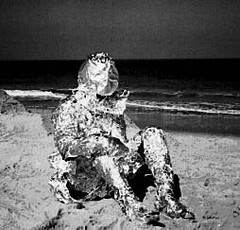Let's Take a Break From Politics: This presidential race has everyone angry and exhausted!
The X Chromosome Resurfaces in the Twenty-first Century
Or, I briefly examine a new study about homosexuality in men, and ask some outlandish questions.
 *
*
A recent study lead by Andrea Camperio-Ciani once again raises the issue of gay genes. I am not thinking about blue jeans worn by homosexual men. Rather, I am writing about a constellation of attributes that are related to male homosexuality. The study titled “Evidence for maternally inherited factors favoring male homosexuality and promoting female fecundity” was based on a sample of 98 homosexual men and 100 heterosexual men, and their relatives. It indicated that genetic factors, and childhood environment coupled with cultural experience all influence male homosexuality. However, I am specifically concerned with parts of the study that discuss a relationship between components of male homosexuality and Mom's X Chromosome. While I was not able to find any in depth material on the study, I did discover that In an interview Camperio-Ciani carefully pointed out that these components are probably located on other chromosomes as well.
Back in the “Gay Nineties” of the late Twentieth Century (Pun intended) several studies pointed toward the possibility that male sexuality was bimodal, like handedness. That is, one is either right handed or left handed. By analogy, one is either gay or straight. And, by extension, like all oppositions in Western thought, one member is dominant and the other is minor. I have a particular bimodal study in mind. It was headed by Dean Hamer (1993), who claimed that male homosexuality was linked to the X Chromosome. The logic behind the premise was further expounded by Chandler Burr in his book, A Separate Creation. However, Hamer’s study demonstrated that homosexuality could be inherited from a variety of sources in addition to the direct inheritance of one or the other sides of a bimodal sexuality exclusively from the X chromosome as Burr claimed. Like all oppositions, the theory of bimodal sexuality in men disallows any other possibilities for the variation of sexuality in human beings, and it begs the following questions. If sexuality is bimodal in men, why are some men bisexual? Why are some men asexual. Why do some heterosexual men have sex with men (such sexual activity even has a name these days, “sex on the down low.”)? Additionally, Hamer himself said, and I am paraphrasing, that half or more of sexual variance is not directly inherited. How then is is it possible for homosexuality in males to be bimodal?
It is interesting that the Camperio-Ciani study is careful not to take the bimodal path to the X chromosome. It is also interesting to note that old fashioned, early to mid Twentieth Century psychology and psychotherapy had claimed that a dominating mother was the cause of homosexuality in men. Instead, Twenty-first Century science is staking a claim that the mother’s genes are dominant because the mothers of homosexual men are more fetile than those of heterosexual men. So, “Mommy made me this way” is back. Additionally, both Twentieth and Twenty-first century research into sexuality are concerned more often than not with male homosexuality. What happened to lesbians? Why aren’t researchers concerned about the causes of male, and / or female heterosexuality?
Further, I wonder, if the the Campiero-Ciani Study is verifieable - and that has yet to be determined - why is it that the genes of mothers of homosexual men are dominant? I realize that the following is speculative, nevertheless, might it actually be beneficial for Mother Nature not only to sustain the homosexual population, but to cause it to increase? A world with more gay men is better than a world with less gay men is an interesting notion. It’s too bad that the idea is idealogical and not provable.
Bailey, J. Michael, and Pillard, Richard. "A Genetic Study of Male Sexual Orientation," Archives of General Psychiatry 48 (December 1991): 1089-1096
Burr, Chandler. A Separate Creation, New York: Hyperion, 1996.
Camperio-Ciani, Andrea, Corna, Francesca, and Capiluppi, Claudio, “Evidence for maternally inherited factors favoring male homosexuality and promoting female fecundity,” The Royal Society, Proceedings: Biological Sciences – Homepage, “http://www.pubs.royalsoc.ac.uk/proc_bio_homepage.shtml,”
© 2004, Saturday, October 23, 2004, 10:59 PM EDT.
“Clip Art Index,” Anti-War Committee: Oranizing Against US Wars Around the World, “http://www.antiwarcommittee.org/images/ClipArtIndex.html,” Sunday, October 31, 2004, 11:23 EST.
Hamer, Dean, H.; Hu, S.; Magnuson, V.L.; Hu, N; and Pattatucci, A. M. L.. “A linkage between DNA markers on the X chromosome and male sexual orientation.” Science 261 (1993): 321-27
E-mail me at ZacSfuts@aol.com
Visit my homepage at AOL Hometown



0 Comments:
Post a Comment
<< Home